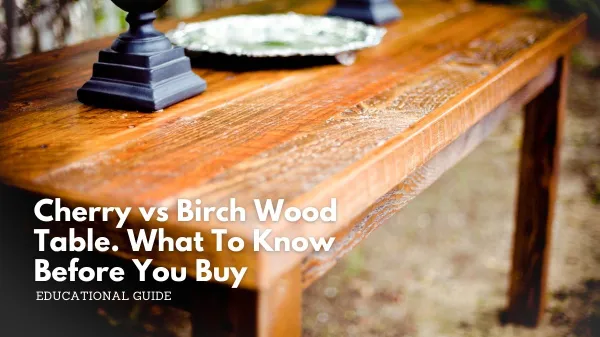Cherry vs Birch Wood Table: What to Know Before You Buy
Choosing the right wood for your home furniture is a significant undertaking. Learning about the wood’s properties, longevity, and how best to use it. The reasons for that can varies, for the aesthetics, the functionality of the wood to the home. Cherry and Birch wood are two of the many types of wood that can be used for furniture, specifically tables. This article will educate readers on the distinguishing characteristics, similarities, and differences between the two woods.
Overview of Cherry Wood and Birch Wood
Cherry Wood
The American black cherry tree (Prunus serotina) is the source of cherry wood. It comes from North America. It is found in places including Ohio, Pennsylvania, and New York. As a hardwood, it is highly valued. It is a popular option for woodworkers due to its strength, workability, and elegance.
The colour of the cherry wood is one of its distinguishing features. As it ages, it undergoes a process known as pagination, which causes its tone to deepen into a rich reddish-brown gradually. Cherry wood comes in various varieties. We have the Brazilian cherry, Patagonian cherry, delicious cherry, and black American cherry.
Table of Contents
Birch Wood
Birch wood originates from the Betulaceae family of plants. Birch, a fast-growing species of tree, is known popularly for its straight inner grain and uniformity. It’s a hardwood, used for various applications. Just like the Cherry wood, the Birch wood is also found in North America, and there are different types of Birch wood, among which are the American birch, white birch, and yellow birch. These are some among many. The yellow is the most popular among them. Although birch has longevity of use, if exposed to harsh conditions, it can experience decay, rot, and insect infestation.
Appearance and Aesthetic Appeal
Cherry Wood
The cherry wood changes colour from when it’s fresh to when it has been overtly exposed to light and air for months. Sometimes, the changes don’t occur until years of exposure. It moves from a light pinkish-gold or pinkish-brown hue to a rich medium reddish-brown color. Cherry wood has a similar grain to the maple wood; it’s fine, straight, and grainy. Sometimes, each piece is unique when it comes out in natural brown flecks, pin knots, and gum pockets.
The colour of the cherry wood changes over months or years, developing deeper reddish tones.
Birch Wood
The birch wood has a pale cream to yellow-brown colour, with sapwood that is creamy white and heartwood that ranges from golden brown to light reddish-brown, depending on the species. These varieties of colour are largely dependent on the species of the Birch wood gotten.
Birch wood has a fine, straight, and uniform grain, which includes a slight wave or curl in the grain. It also has a natural stain-like sheen. It’s easy for rot and damage to happen, as it is susceptible to it, yet dense and durable.
Durability and Maintenance
Cherry Wood
Cherry wood, known for its medium weight, is a hardwood that has a high compressive strength, which makes it durable for indoor use. It isn’t affected by the changes in humidity and temperature, except when it is open to outdoor weathering.
Cherry wood is easy to maintain. It involves making sure the wood is dry at all times and regular cleaning with a slightly damp cloth. Oil must also be applied to enhance its warm, reddish tone and smooth surface. Oil, like linseed or walnut oil, can be used. With proper maintenance, cherry wood develops a good-looking patina over time, which makes it more pleasing aesthetically.
Birch Wood
Birch wood, known for its light colour, smooth grain, is a hardwood with a sturdy nature. It isn’t as prone to scratches and dents compared to other woods, which makes it a good choice for furniture and cabinet uses. It is durable and resistant to wear and tear.
Maintaining birch wood involves a regular soft dusting and cleaning with mild detergent while avoiding abrasive materials. Too much sunlight can cause fading and warping, so direct sunlight should be avoided at all costs. Birch wood is generally known for its durability, and it functions as a top wood when strength is a top priority.
Cost and Availability
Cherry Wood
Cherry wood is considered to be an average hardwood. The cost varies according to the thickness of the wood. According to Homestratosphere, per board foot prices range approximately from $2.95 to $15.25. This depends on the quality and features, like curly grain or quartered cuts. Cherry wood availability ranges from North America, mainly Pennsylvania, New York, and Wisconsin, which can only be limited because of demand.
Birch Wood
Birch wood, generally considered a medium hardwood, is less expensive than cherry wood. It’s assumed to be budget-friendly in comparison to other woods of decent quality. Lumber size is between the range of $6.29 and $8.00. it has a good availability rating compared to cherry wood, and it doesn’t require great care and attention.
Check out our articles on common mistakes to avoiding when getting a dinner table
Sustainability and Environmental Impact
Cherry Wood
Cherry wood is very sustainable, as it is reported to capture carbon from the atmosphere during growth, acting as a carbon sink. Cherry wood is common, and harvesting can be done without causing much damage to the forest. It also acts as support for various wildlife species, so careful forestry management is needed to minimise biodiversity impacts.
Birch Wood
Birch wood is a fast-growing species of wood. This makes it sustainable and easier to replenish relative to slower-growing hardwoods. It also has a positive influence on soil nutrients and biological turnover, supporting ecosystem health. Birch wood can be affected by increased temperature and droughts in regions of impact.
Workability and Finish
Cherry Wood
Cherry wood is easy to work with both hand and power tools; cherry wood takes stain and polish well, though it may darken unevenly without proper finishing. It ages gracefully with oil or clear finishes, highlighting the grain.
Birch Wood
Birch wood is also easy to work with, particularly with machine tools, but can be challenging to stain evenly due to high porosity. It accepts paints and clear coats well and is favored for plywood and lightweight furniture components.
Conclusion
Both cherry and birch wood are excellent choices for tables, each offering unique benefits. Cherry wood stands out for its rich colour, smooth texture, and graceful ageing, while birch wood offers affordability, light tone, and sturdy construction. When choosing between them, consider your budget, design preference, and maintenance commitment. A cherry wood table suits those seeking elegance and long-term value, while birch wood is ideal for practicality and a clean, modern look.

